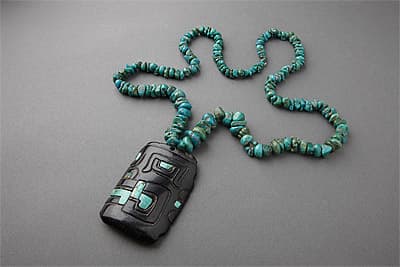
PACOPAMPA culture Northern highlands 1200 BC – 1 BC
Necklace 1200 BC - 1 BC black porphyry, turquoise, chrysocolla42.2 (h) x 47.0 (w) x 0.9 (d) cm Museo Larco, Lima Photograph: Daniel Giannoni
The pendant of black porphyry represents a human face transforming into a feline—probably a jaguar. The eyes, mouth and claws are engraved with strong lines. Inlaid turquoise emphasises the fanged mouth, and the head pendant is suspended from a necklace of turquoise and chrysocolla beads. Such a rare and extraordinary piece of bodily adornment would certainly have been created for someone important, perhaps a shaman or another religious figure such as a priest–king.
Pacopampa is an archaeological site in northern Peru, in the modern department of Cajamarca. The nearby town is named for the Quechua term ‘paqu pampa’ (‘plain where alpacas graze’). The original excavations were made by Rafael Larco Hoyle in the 1930s, although in recent years other temples and burial sites have been found. Like Cupisnique, the Pacopampa culture seems to have overlapped with Chavín (1500–200 BC); the three cultures possibly influenced each other, especially in the realm of religious ideas and their artistic expression.
Christine Dixon
The pendant of black porphyry represents a human face transforming into a feline—probably a jaguar. The eyes, mouth and claws are engraved with strong lines. Inlaid turquoise emphasises the fanged mouth, and the head pendant is suspended from a necklace of turquoise and chrysocolla beads. Such a rare and extraordinary piece of bodily adornment would certainly have been created for someone important, perhaps a shaman or another religious figure such as a priest–king.
Pacopampa is an archaeological site in northern Peru, in the modern department of Cajamarca. The nearby town is named for the Quechua term ‘paqu pampa’ (‘plain where alpacas graze’). The original excavations were made by Rafael Larco Hoyle in the 1930s, although in recent years other temples and burial sites have been found. Like Cupisnique, the Pacopampa culture seems to have overlapped with Chavín (1500–200 BC); the three cultures possibly influenced each other, especially in the realm of religious ideas and their artistic expression.
Christine Dixon
The pendant of black porphyry represents a human face transforming into a feline—probably a jaguar. The eyes, mouth and claws are engraved with strong lines. Inlaid turquoise emphasises the fanged mouth, and the head pendant is suspended from a necklace of turquoise and chrysocolla beads. Such a rare and extraordinary piece of bodily adornment would certainly have been created for someone important, perhaps a shaman or another religious figure such as a priest–king.
Pacopampa is an archaeological site in northern Peru, in the modern department of Cajamarca. The nearby town is named for the Quechua term ‘paqu pampa’ (‘plain where alpacas graze’). The original excavations were made by Rafael Larco Hoyle in the 1930s, although in recent years other temples and burial sites have been found. Like Cupisnique, the Pacopampa culture seems to have overlapped with Chavín (1500–200 BC); the three cultures possibly influenced each other, especially in the realm of religious ideas and their artistic expression.
Christine Dixon

